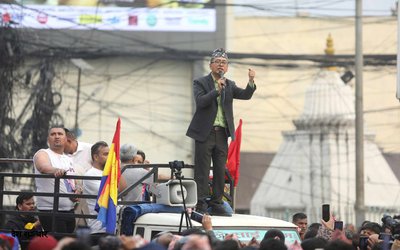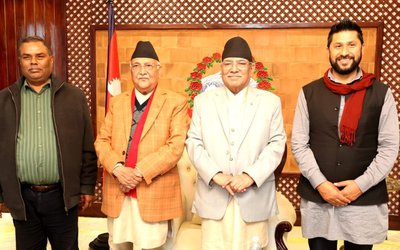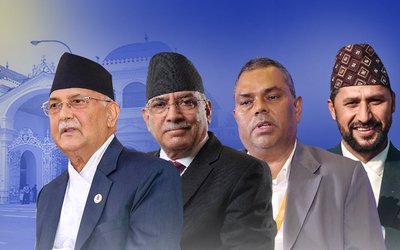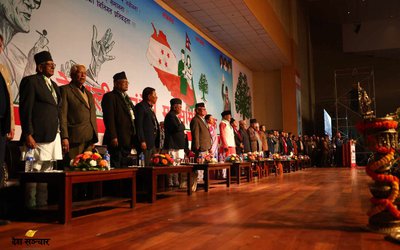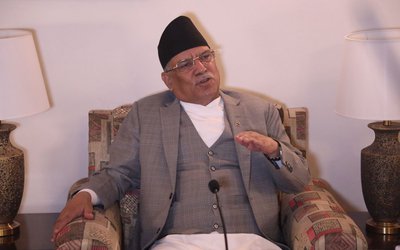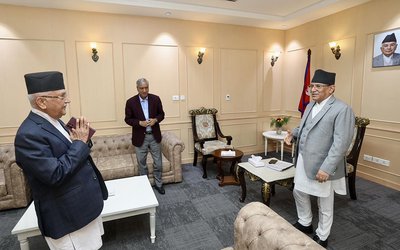For many political pundits, Nepal’s alliance making and breaking sounds strange. There is no right, left, center or extreme left in making alliances. Regressive or progressive forces come together without looking at their own history and ideology. If one looks at the political history of Nepal, nothing is impossible.
The recently formed rainbow alliance of 22 political parties led by Unified Communist Party of Nepal-Maoist is an example. Although the regional based Madheshi front, a political force harping on the ideology of extremely rightist agenda of regional group of the south, Chure Bhabar Party, another regional party championing the identity of people living in inner Chure hills, Nepa Party, singly identity based Kathmandu Valley’s ethnic based party, and Unified Communist Party of Nepal- Maoist, Communist Party of Nepal Marxist and Leninist, Socialist Party and Communist Party of Nepal (United), and four class based ideological communist parties, have nothing in common, they announced a long term political alliance.
Instead of sharing common stand, these parties hold hostile views against one another. For example, United Democratic Madheshi Front, which is a rainbow of five southern based parties, is demanding all 22 districts of southern Nepal as a single unit, joined the front with Chure Bhabar Unity Party which wants single province along Chure Hill. This is against UDMF demand. Similarly, UCPN-Maoist proposes five provinces in Terai, Communist Party of Unified has a different demand.
Despite such contradictory and hostile demands, the new front has been set up. UCPN-Maoist leader Prachanda claims that his alliance will pursue single identity based federalism till holding the elections. Prachanda is yet to answer how this alliance will go with Madhesh based parties as UCPN-Maoist still retains its proposal for five provinces, Kochila, Mithila, Bhojpura, Abadh and Tharuhat, in Nepal’s southern province, including a separate autonomous status for Chitwan and Nawalparasi districts.
Politically, Madheshis and Maoists were hostile to each other as the Madhesh movement was born following, reportedly, the firing by Maoist leader Ram Karki in 2007 in Maoist demonstration held in Lahan. Whatever the stand they do have, the newly formed front claimed that they will safeguard their interest.
UCPN-Maoist led front is not only one which is composed of groups of different hostile parties. Ethnic groups composed from various parts of Nepal decided to form a political party. It remains to be seen how they manage their boundaries for single identity province. For instance, Limbus want their state with Jhapa and Morang as part, two Madhesh districts. Similarly, Koche wants Jhapa as separate province. Tharus have already demanded single province in terai from east to west. Madheshis have their well known demand for one Madhesh, one Pradesh, and Muslims demand separate province for them. Despite so many contradictions and hostilities, they have agreed to form a broader alliance or separate political parties.
No matter what ideologies they belong to and what inimical relations they have amongst themselves, the political parties have formed the strange alliance. A few years ago, when Madheshi parties were in alliance with CPN-UML and Nepali Congress, they were regarded as democratic despite their known regional stands. Maoist charged them with being anti-national communal forces then. Even UCPN-Maoist launched a nationwide agitation terming NC-UML and Madheshi alliance as anti-national broker under Indian influence. Now, CPN-UML and Nepali Congress is labeling Maoist-Madheshi front as antinational.
CPN-UML leader Jhalnath Khanal labeled the newly formed alliance as created by foreign forces claiming that no revolution in Nepal will succeed by bowing down to India. However, Khanal was one of the key figures in New Delhi to broker the 12 point agreement which was signed in New Delhi in 2005.
Similarly, Nepal Congress and CPN-UML are leading another alliance of 23 political parties, consisting of RPP, a regressive political party, and other various regional and local parties. At a time when each political party is suffering from internal dissention, making their own political party as a front of various groups, no body understands how they can sustain a broader new alliance.
For instance, Nepali Congress has two competing factions led by former prime minister Sher Bahadur Deuba and Sushil Koirala. Similarly, UCPN-Maoist too has continuation of prime minister Baburam Bhattarai’s group and Prachanda and deputy prime minister Narayankazi’s group. CPN-UML too is suffering from groupism of Jhalanath Khanal and Madhav Nepal and K.P. Sharma group. CPN-UML leader Jhalnath Khanal labeled the newly formed alliance as created by foreign forces claiming that no revolution in Nepal will succeed by bowing down to India. However, Khanal was one of the key figures in New Delhi to broker the 12 point agreement which was signed in New Delhi in 2005.
Similarly, Nepal Congress and CPN-UML are leading another alliance of 23 political parties, consisting of RPP, a regressive political party, and other various regional and local parties. At a time when each political party is suffering from internal dissention, making their own political party as a front of various groups, no body understands how they can sustain a broader new alliance.
For instance, Nepali Congress has two competing factions led by former prime minister Sher Bahadur Deuba and Sushil Koirala. Similarly, UCPN-Maoist too has continuation of prime minister Baburam Bhattarai’s group and Prachanda and deputy prime minister Narayankazi’s group. CPN-UML too is suffering from groupism of Jhalanath Khanal and Madhav Nepal and K.P. Sharma group.
- TANAHU HYDROPOWER PROEJCT: A Significant Achievement
- Apr 15, 2024
- AMBASSADOR HANAN GODAR: Sharing Pain With A Nepali Family
- Mar 30, 2024
- VISIT OF KfW AND EIB TO NEPAL : Mission Matters
- Mar 25, 2024
- NEPAL BRITAIN SOCIETY: Pratima Pande's Leadership
- Mar 24, 2024
- NEPAL ARMY DAY: Time To Recall Glory
- Mar 15, 2024

